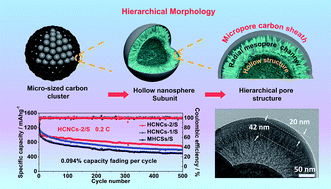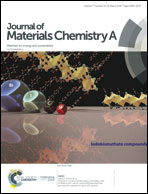Promoting sulfur immobilization by a hierarchical morphology of hollow carbon nanosphere clusters for high-stability Li–S battery†
Abstract
Immobilization of sulfur on a conductive carbon host is a valid way to resolve the insulating nature of sulfur and relieve the polysulfide shuttle. Herein, we enhanced the physical immobilization efficiency of sulfur through deliberate design of a carbon nanostructure, which integrated microporous, mesoporous and hollow nanostructures into a micrometer-sized particle. A hierarchical morphology of hollow carbon nanosphere clusters (HCNCs) was fabricated for the first time using a colloid chemistry route combined with spray drying technology. The as-prepared HCNCs have numerous interior hollows achieving higher sulfur-loading and buffering volume expansion, mesoporous channels for rapid ion transfer, and a microporous carbon sheath minimizing lithium polysulfide shuttling. This unique carbon architecture endowed HCNCs/S composites with superior cyclability and rate capability. They could deliver a high initial capacity of 1311 mA h g−1 at 0.2C and a reversible capacity of 695 mA h g−1 after 500 cycles with a low capacity fading rate of 0.094% per cycle. The sulfur cathode demonstrated good rate capability, with 592 mA h g−1 at 5C. Integrating different morphologies and pore structures can embody the merits and mitigate the shortcomings of every individual component, which can be an effective path for future development of high-rate and long-cycle Li–S batteries.



 Please wait while we load your content...
Please wait while we load your content...